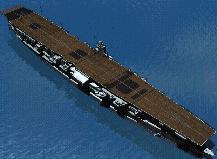
December 6, 1920-The keel of the Akagi is laid down in the Kure naval shipyards as an Amagi-class battlecruiser.
February 1922-Work on the Akagi is halted until after the Washington treaty is negotiated, and plans to convert the hull to an aircraft carrier begin.
November 17, 1923-Conversion of the Akagi to an aircraft carrier begins, with original plans including a three-level flight deck.
April 22, 1925-The Akagi is launched.
March 25, 1927-The Akagi is completed at the Yokosuka Naval Shipyards, and enters service as the flagship of the First Carrier Division.
October 24, 1935-The Akagi enters drydock to undergo modernization. Among the modifications, the triple flight deck is replaced by the single flight deck running the length of the carrier.
August 31, 1938-The Akagi is ready for service after modernizations are completed.
September 5, 1940-The Akagi leaves Yokosuka for Kure, staying less than two weeks at its destination.
November 15, 1940-The Akagi becomes a special duty ship in Yokosuka Naval District .
April 10, 1941-The Akagi becomes the flagship of the newly formed First Air Fleet and assigned to Carrier Division 1, Air Fleet 1.
November 26, 1941-The Akagi leaves Hittokapu Bay in the Kuriles as Vice Admiral Chuichi Nagumo's flagship of the carrier strike force ('Kido Butai') in the raid against Pearl Harbor ('Hawaii Operation'), only four days after arriving.
December 7, 1941-Akagi's torpedo planes sink the United States battleships West Virginia and the Oklahoma.
December 23, 1941-The carriers Akagi, Kaga, Shokaku, and Zuikaku return to Hishirajima.
January 17, 1942-Carrier Divisions One and Five depart Hasirajima, arriving in Truk after a stop in Iwakumi, readying to participate in an attack that would be responsible for covering the invasion of Rabaul and the areas around it.
January 20, 1942-The Akagi carries out air strikes on Rabaul, followed by Kavieng, and then re-attacks Rabaul on the 22nd.
February 1, 1942-The Akagi departs Truk (after returning on the 17th), in an attempt to catch the enemy ships responsible for the attack on the Marshall Islands.
February 8, 1942-The Akagi arrives at Palau after aborting pursuit of the attackers. The carrier would leave on the 15th, with the carrier Kaga to attack Port Darwin and Davao, Australia. These attacks are carried out on the 19th.
February 25, 1942-The Akagi departs Staring Bay (arrived the 21st) to cover the invasion of Java.
March 26 to April 23, 1942-The carriers Akagi, Hiryu, Soryu, Shokaku, Zuikaku, battleships Kongo, Hirishima, Hiei, Haruna, cruisers Chikuma and Tone, and the 1st Destroyer Squadron depart to attack several Royal Navy bases in the Indian Ocean. The primary bases that were attacked were bases at Columbo and Trincomalee. This operation would lead to the sinking of the Royal Navy carrier Hermes.
April 19, 1942-The Akagi departs to pursue the Doolittle Raiders that attacked Tokyo the day before. Carrier Division 5 embarks on Operation MO (Battle of Coral Sea).
April 22, 1942-The Akagi and striking force arrives in Hashirajima.
May 25, 1942-Striking force departs Hasirajima (with Carrier Divisions 1 and 2. Carrier Division 5 will not depart due to the aircraft losses to the Zuikaku and damage to Shokaku in the Battle of the Coral Sea) Hashirijima.
June 4, 1942-The Akagi prepares to attack Midway Island. At 10:26 a.m. the carrier was struck by aircraft from the USS Enterprise, setting off secondary explosions from the many armed and fueled Japanese aircraft parked flight deck. The Akagi's rudder jammed 20 degrees to port since the carrier was attempting a maximum turn, effectively locking the ship to move in circles. Vice Admiral Chuichi Nagumo changes the flagship to the Nowaki, and then to the Nagara. The engines begin to falter, and finally quit at 1:50 p.m. Less than two hours later, the ship is evacuated aside from Captain Aoki and a small damage party. The carrier burns throughout the night, but does not sink.
June 5, 1942-Commander in Charge of the Combined Fleet, Admiral Isoruku Yamamoto (Captain of the Akagi in its first two years), orders that the carrier be sunk. At 5:20 a.m, the Akagi is scuttled, and sinks bow first from torpedo holes inflicted by the four Japanese destroyers: the Maikaze, Nowaki, Arashio, and Hagikaze. Over 1,000 crew is rescued (although the captain was forced off of the ship), and only 263 members of the crew are lost. The surviving crew is moved from the destroyers to the battleship Mutsu.
Statistics:
Armaments: